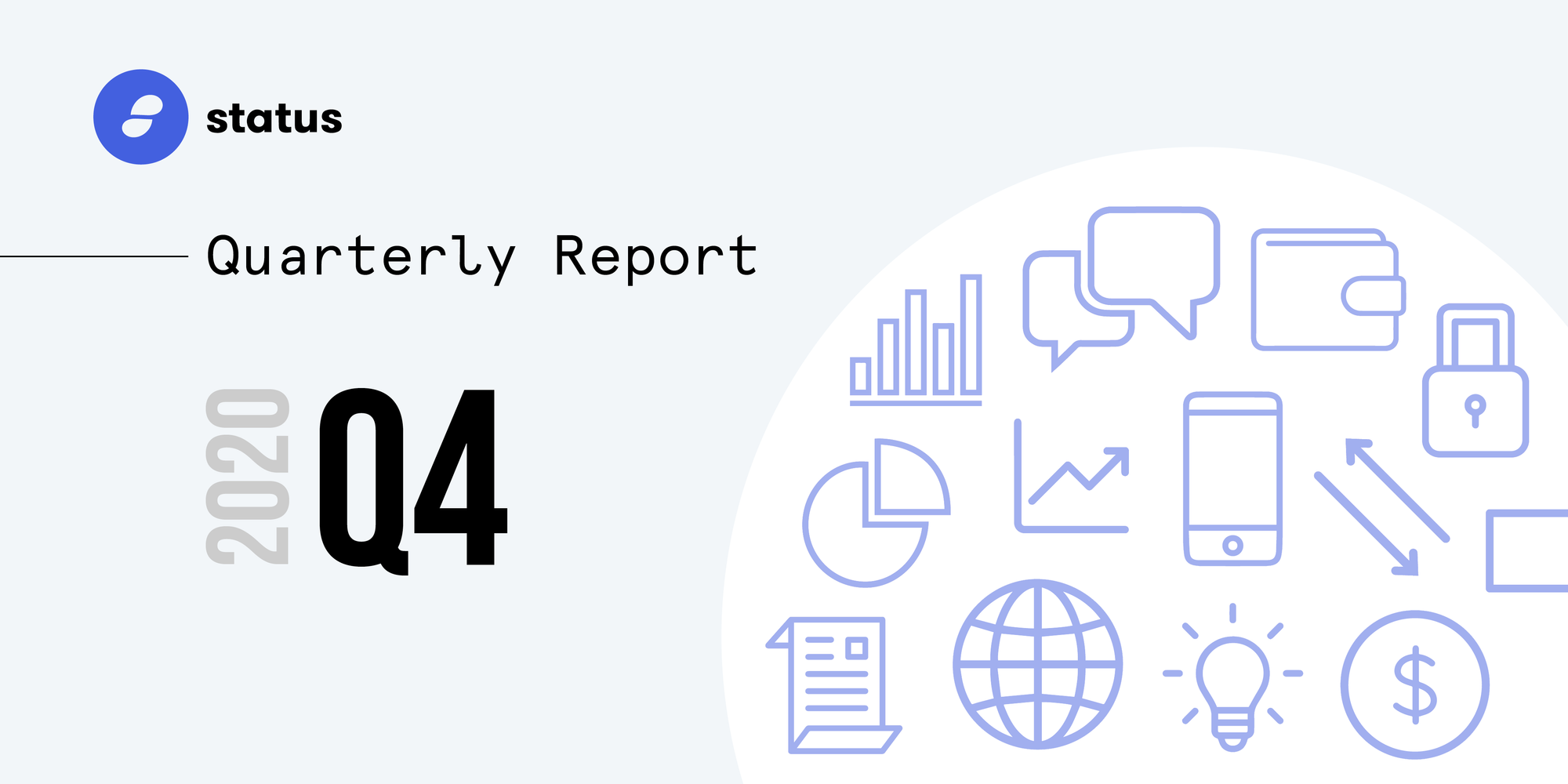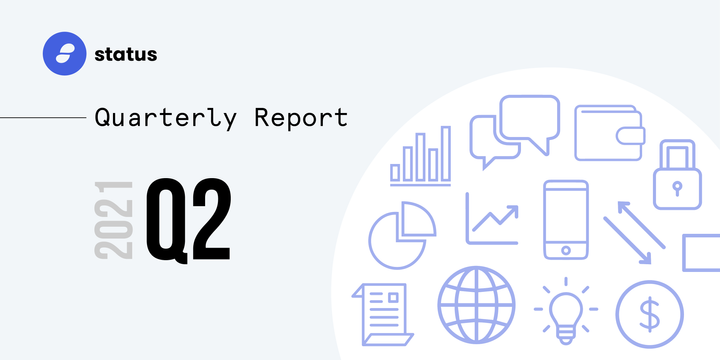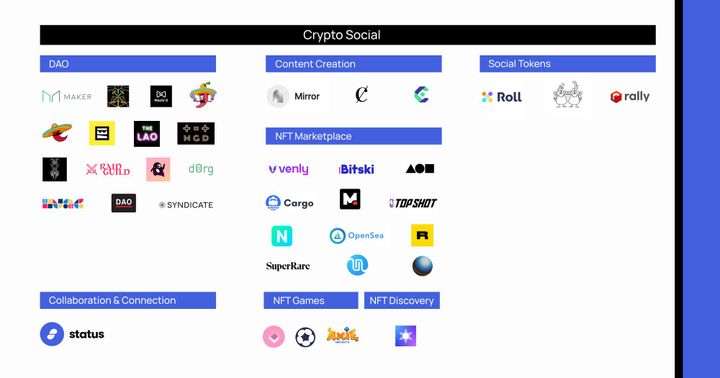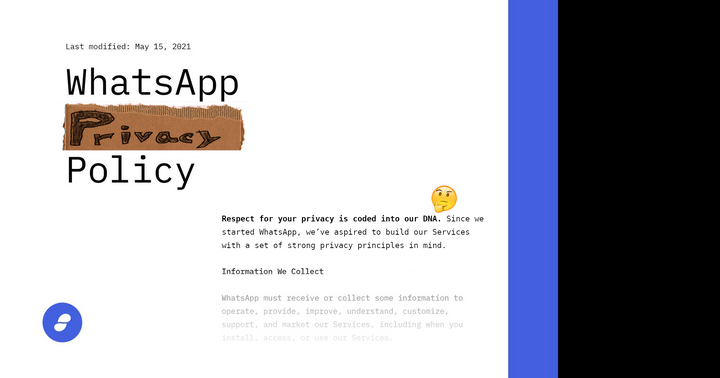[Thanks to our wonderful community of translators, you can read this report in Español, Português, 中文, Русский, Tagalog, 日本語, and 한국어 <3]
1. Welcome
We’re back with the final Status Network Quarterly Report of 2020 and what a way to close out the year. The end of 2020 saw significant progress across the network on the Status App, Nimbus, and Waku, as well as a strong strategy for the future.
The team of core contributors and passionate community members continue to build and ship the infrastructure, tools, and products that enable our mission of protecting the right to private, secure conversations, and promote the sovereignty of individuals.
When looking at the various elements of The Status Network, one can see the broader vision of private, secure communication and how all the projects in the network come together in pursuit of this vision.
Designing and building at each layer requires exhaustive effort to ensure security and privacy are native to the work and not simply an afterthought. This requires deep exploration of the tradeoffs between privacy and convenience with bleeding edge technology. This report will outline the progress made across The Status Network in Q4 2020.
2. Status App

MOBILE APP
The focus for Q4 was providing a more social, engaging, and stickier experience in Status. With this goal in mind, the team was heads down designing and building for the following releases of a secure messaging app:
- V1.8 Release - More people, more private and bug fixes. This release increased the capacity of private group chats from 10 to 20 while maintaining the same privacy and security guarantees as previous versions.
- V1.9 Release – “What’s your status?”. This release introduced the “Status” tab in the tab bar for people to set a status update for their contacts to see. It also introduced link previews in chats to make the public channels more visual, in-app push notifications for transactions (beta), and smoother onboarding into public chats.
In Q4, we had ~600k new Android installs (according to Google’s Play Console) and ~1800 new installs on iOS (according to Apple’s App Store Connect). The team has also been more closely measuring daily retention of newly onboarded users.
Notably, Status saw a then all time high of active peers in the network on the day of an AMA with Vitalik Buterin.
- 843 messages sent (5x the average at the time) written by 135 users
- Over 8000 app installs that day
- ~6500 new peers
DESKTOP APP
With design and architecture decisions made, and an initial beta release under their belt, the Status Desktop team started shipping at an astounding rate–further bringing private, secure communication no matter where you are, on the go with your smartphone or while at work at your desk.
The team released Desktop v0.1.0-beta.2, Desktop v0.1.0-beta.3 and Desktop v0.1.0-beta.4 and achieved feature parity with mobile. The product is still in beta but includes core functionality such as:
- P2P messaging with Waku
- Integrated Ethereum wallet - available to toggle in advanced settings
- Web3 DApp Browser - available to toggle in advanced settings
- Status timeline
- Initial support for communities
- Suite of UI features such as native OS notifications, link unfurling, profile pictures, file attachments, emojis, mentions, reactions, and many other UI improvements
The Desktop App still hides the ethereum wallet and dapps browser tabs by default while still in beta. But with the progress being made by the team, the goal is to conduct an audit and move out of beta in the coming months.
The latest Desktop beta can be downloaded for Mac, Windows, and Linux here.
3. SNT utilities
The Status Network Token (SNT) is the utility token that powers and incentivizes the Status Network.
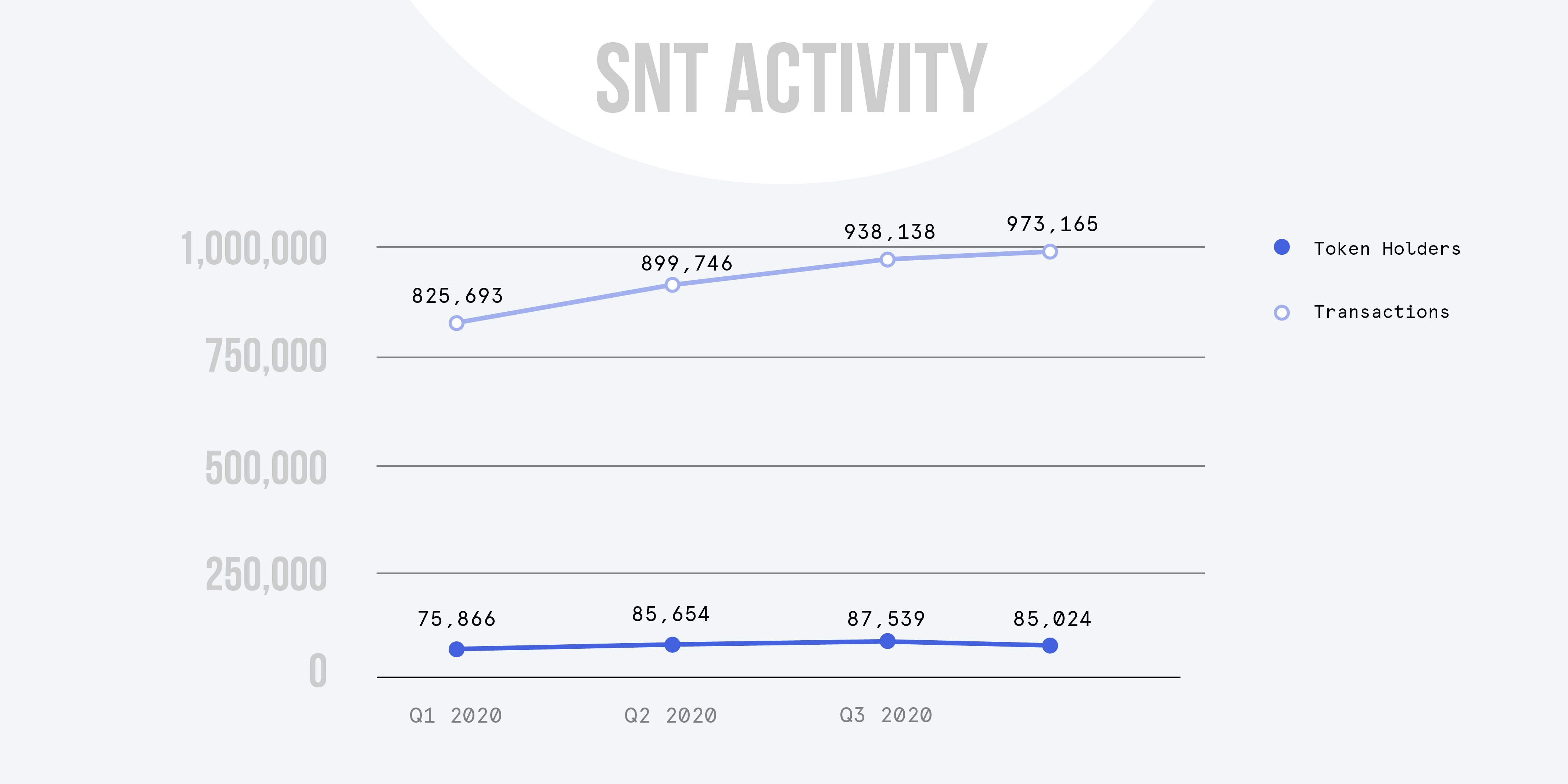
There are currently 85,024 SNT holders, with 973,165 transfers made to date, and a total supply of 6,805 million SNT. You can see more token metrics here, as well as our own SNT analytics dashboard over at: https://analytics.status.im/.
Many SNT utilities are designed as microtransactions within the application and network itself. However, with gas prices hitting crazy levels, these transactions became less realistic considering the expensive network fees.
This led the team to further analyze and investigate Layer 2 solutions that are suitable for Status.
Checking in on our SNT utilities live and in development, we have:
Live
- ENS Usernames - An ENS username is a stateofus.eth handle that users can register by locking up 10 SNT, giving them a more human readable username than a contact code. There are currently 4,906 ENS usernames registered by 1,854 owners, with SNT 49,060 locked in the contract. 208 of these ENS names were registered in Q4 2020.
- Dap.ps - A curated list of DApps that relies on a unique economic mechanism to rank information without any centralized authority benefiting. Q4 saw Matcha become the highest ranked DApp with 83,701 SNT staked. Tons of new DApps featured on dap.ps such as:
- POAP - Proof of Attendance Protocol
- DerivaDEX - the next generation of crypto derivatives and decentralized insurance fund
- Penguin Swap - Uniswap Front End with added preferred coins for cheaper routing pairs
- Teller - The source code and documentation for this project is live and available for open deployment at teller.exchange. The future of Teller is in the hands of the community.
- Sticker Market - A marketplace for artists and creators to upload and monetize their design work by selling sticker packs directly within the Status app in exchange for SNT. Lots of cool new stickers available for free and for purchase with SNT.
4. Product and swarm updates
Keycard
Keycard is a secure, contactless hardware wallet, which, when integrated with Status, enables users to:
- Store their private keys offline on the Keycard device
- Add hardware-enforced authorizations to all their transactions, and
- Introduce two-factor authentication to log into their Status account.
In Q4, the Keycard team focused on the iOS integration with the Status Mobile App, making the Keycard offering more extensive and the Status experience more robust. They also prioritized how Status users can easily transfer their regular accounts (with no keycard) to a Keycard for increased security.
Finally, the team started to explore distribution strategies for increased Keycard sales.
Learn more about Keycard and get your own at keycard.tech.
Embark
Active work on the Embark Framework has been on pause, as the Embark team has been focused on building the Status Desktop app, as well as integrating Embark with Status, so no updates to report for this edition.
Nimbus
The Nimbus team had a momentus Q4 with the mainnet launch of the Nimbus client:
- Announced our v1.0 mainnet release -- Stateofus. This release built off our alpha release -- Hope (the first audited and stable release of our beacon node software). Our fleet is currently running smoothly on Ethereum 2 mainnet.
- Closed all of the important issues raised in our three-way audit (conducted by ConsenSys, NCC, and Trail of Bits).
- Completely revamped and updated the Nimbus book (the main port of call for all validator related documentation).Moving forward with plans to integrate Nimbus into Status-desktop and eventually the Status mobile app. This is how Nimbus will be spread to the community. Waku is the first step here -- the chat protocol works on top of Waku; Waku v2 is planned to be Nim-first.
Stimbus
Stimbus is a project that implements the current backend library status-go in the NIM language, with the goal of bringing closer integration with the Nimbus and Vac projects and bringing Waku v2 into the mobile and desktop app. The team has implemented many apis & endpoints over from status-go into stimbus, it is completely compatible with the existing database of status-go and is currently used by status desktop. The team has done extensive research on a concurrent architecture for Stimbus and work is now ongoing in implementing it.
Vac
Vac, the team behind the underlying messaging protocol in use by Status, has been heads down working on Waku v2. Waku v2 is a general-purpose private p2p messaging protocol that seeks to address some of the limitations of Waku, such as scalability. A summary of its motivations and goals can be found here.
First and foremost, Hanno Cornelius has joined the team and has been working on the JSON RPC API.
In Q4, the team outlined primary goals for the coming months which are outlined on the Vac forum here. The goals are:
- Getting our first users, aka production-ready
- Making it worth using
Q4 also saw the initial beta release of the `nim-waku` codebase, which included the first implementation of the Waku v2 protocol.
Click here to learn more about the history of Waku including:
- The journey from Whisper to Waku v1
- Transition from Waku v1 to v2
- Breakdown of Waku v2 including design goals and upcoming plans
Full details of the presentation are documented here.
Marketing
Q4 was an important quarter for Status growth and marketing considering all the exciting things that happened around the ecosystem.
- Status and Nimbus signaled support for the anonymously deployed contract to be the canonical deposit contract for Eth2.
- Find a Breakdown of Account Abstraction (EIP-2938) in this detailed article.
- Dego in Defi - With the explosion of governance tokens in the world of Defi, we outlined the technical processes behind Decentralised Governance (DeGo) in Decentralised Finance (DeFi) protocols on Ethereum.
On October 8th, we had one of the busiest days ever in the #status public channel as we hosted an AMA with Vitalik Buterin. Vitalik responded to comments and questions from the global community as we saw record numbers of concurrent peers (at the time).
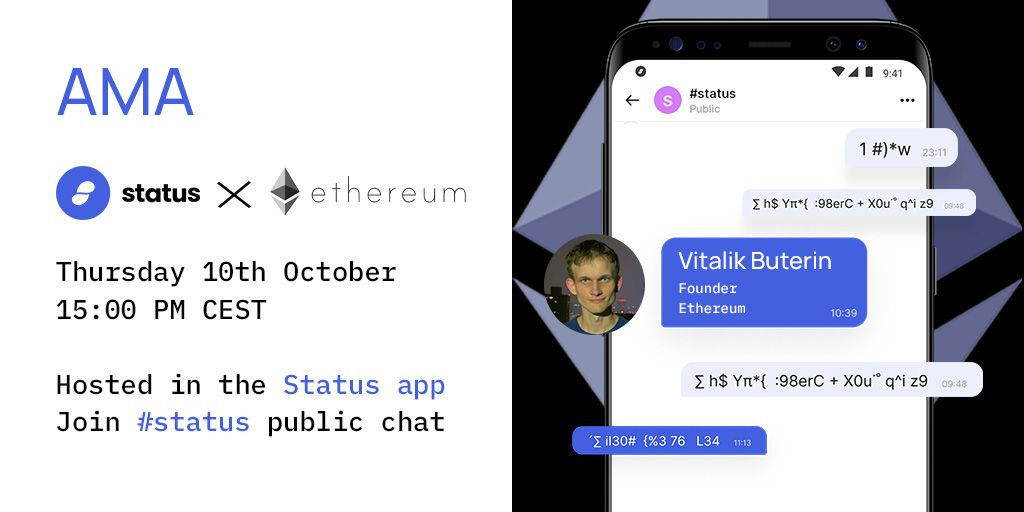
We followed up the Vitalik AMA with more community AMAs including:
- Garth Travers of Synthetix
- Eli Duarado
- John Craine of SuperRare
- Grammy Award winning artist RAC
- Fernando Martinelli of Balancer Labs
Efforts in Latin America progressed nicely with some key influencers promoting Status. Criptomaniacos, Felipe Percigo, and Bruno Germano in Brazil created tons of content introducing Status to the Brazilian community. BlockLatina, Inaki, and Paul Ironforce showcased Status in Argentina, while Juan en Cripto kicked things off in Colombia.
Status core contributor, Juan David Reyes, also kicked off a meetup for the crypto art community called #CryptoAtelier.
Don't miss the #CryptoAtelier launch – the artistic workshop for Latam creators.
— Status (@ethstatus) December 14, 2020
📆 When: TOMORROW, Dec 15, 23:00 UTC
🔴 LIVE: https://t.co/9SEiotqHAp
🗣️ Panel @cryptoartsy @SuperRareJohn @PowerDada
🖌️ Live drawing at @PowerDada
🎧 After VR party with @MusicalBlockchn pic.twitter.com/BazydOToZR
Status appeared in global press in Q4 with features in CoinTelegraph, What the Dev Podcast by SD Times, and several Latin American based publications including Noticias CryptoMarket, iProUp, and Crypto Resources.
You can follow along with the Marketing team’s plans in real time here.
5. Funding
Project financials
For ease of reference, we’ve shown our financial data in this report in USD. When putting together this information, we used the following Coingecko exchange rates to convert ETH balances:
- Q1 2020, 31/3/2020, 1 ETH = ~$133
- Q2 2020, 30/6/2020, 1 ETH = ~$225
- Q3 2020, 30/9/2020, 1 ETH = ~$382
- Q4 2020, 31/12/2020, 1 ETH = ~$980
- These are unaudited pro forma consolidated values and are subject to changes upon finalisation of financial statements for FY 2020.
- Values for this quarter have been restated given a different categorisation for actual costs.
- Idem.
While technically part of the Q4 strategy, to secure a longer runway for operations, we executed several market transactions to prolong Tier 1 runway to 18 months.
At the date of this report, the current assets position in treasury is as follows:
165.5 million USD: Total assets in treasury
- 20.6 million USD: Tier 1 assets (fiat)
- 75.2 million USD: Tier 2 assets (crypto)
- 69.7 million USD: Tier 3 assets (SNT)
Given our assets position, the runway is as follows:
141 months: Total runway @ market value of portfolio
- 18+ months: Tier 1
- 63+ months: Tier 2
- 60+ months: Tier 3
6. Conferences and events
Despite the global pandemic, the Status team managed to participate in a number of online (non-location based) events in Q4 including The Vancouver Biennale in partnership with #ArtProject.io, Taipei Ethereum meetup, 2.5 by ETHBerlin, ETHOnline by ETHGlobal, and Welcome to Web3 by Gitcoin.
7. Contributors
Core contributors
As we reached the end of a year nobody will easily forget, we also reached the highest number of core contributors/community freelancers since 2018, closing 2020 with 73 employees.
While our core contributor count is up, we want to give a shoutout and fond farewell to Ceri Powers who left the team to pursue other opportunities. She was an incredible force in the Status team and while sad to see her go, we wish her the best of luck.
We’re still looking to expand the team with some key skills and contributions. In Q1, we want to add:
- Accountant - to support the finance team
- Waku JS and Wallet integrations lead - leading the push to integrate decentralized M2M messaging into both our mobile and desktop products and 3rd party wallets
- Nim developer - for the Nimbus team
- Protocol Engineer - to research and develop open protocols for secure messaging
- Product Engineer - to transform specifications into interactive interfaces with the Core Team
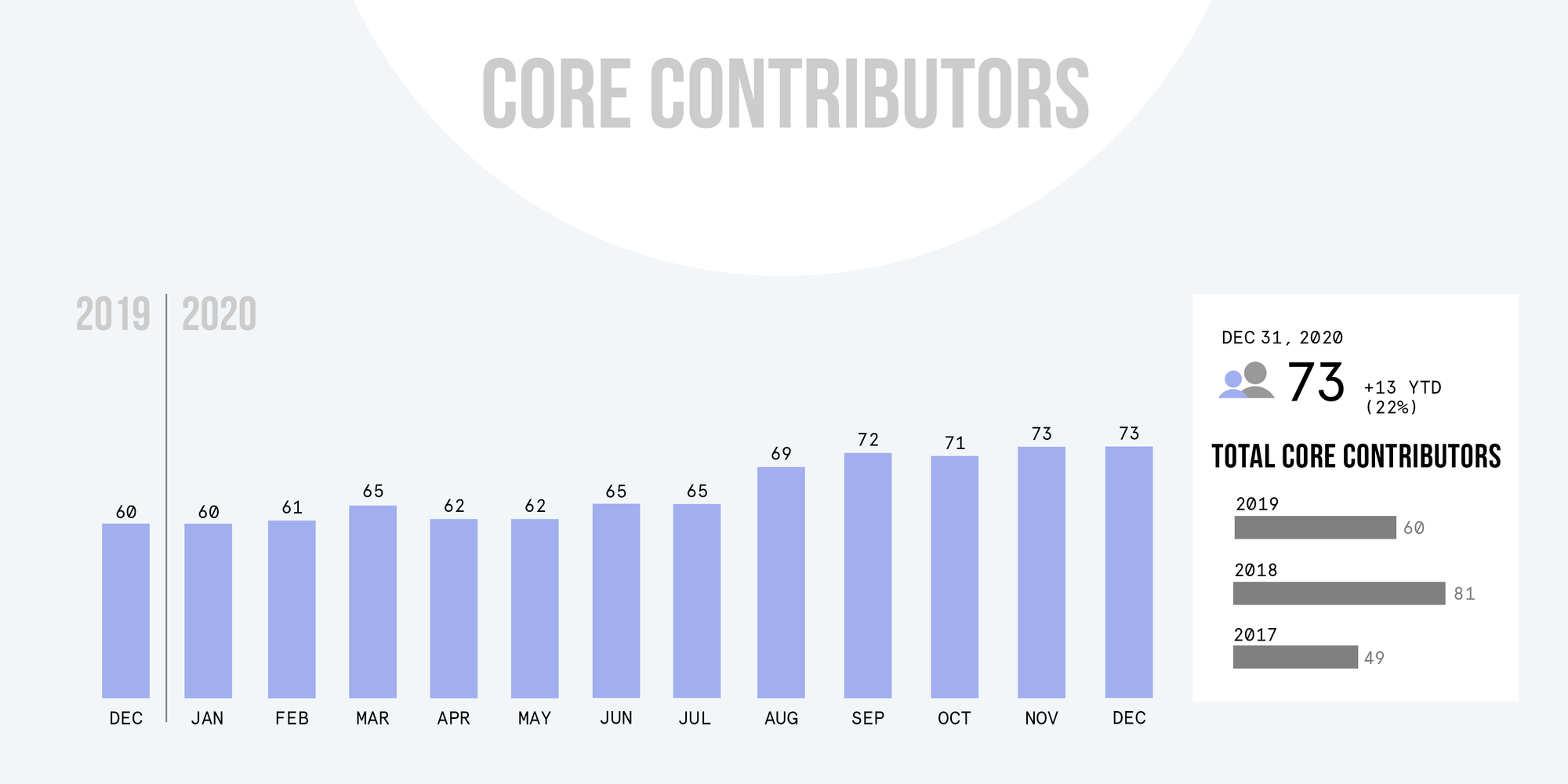
Turnover has decreased slightly in the past few months:
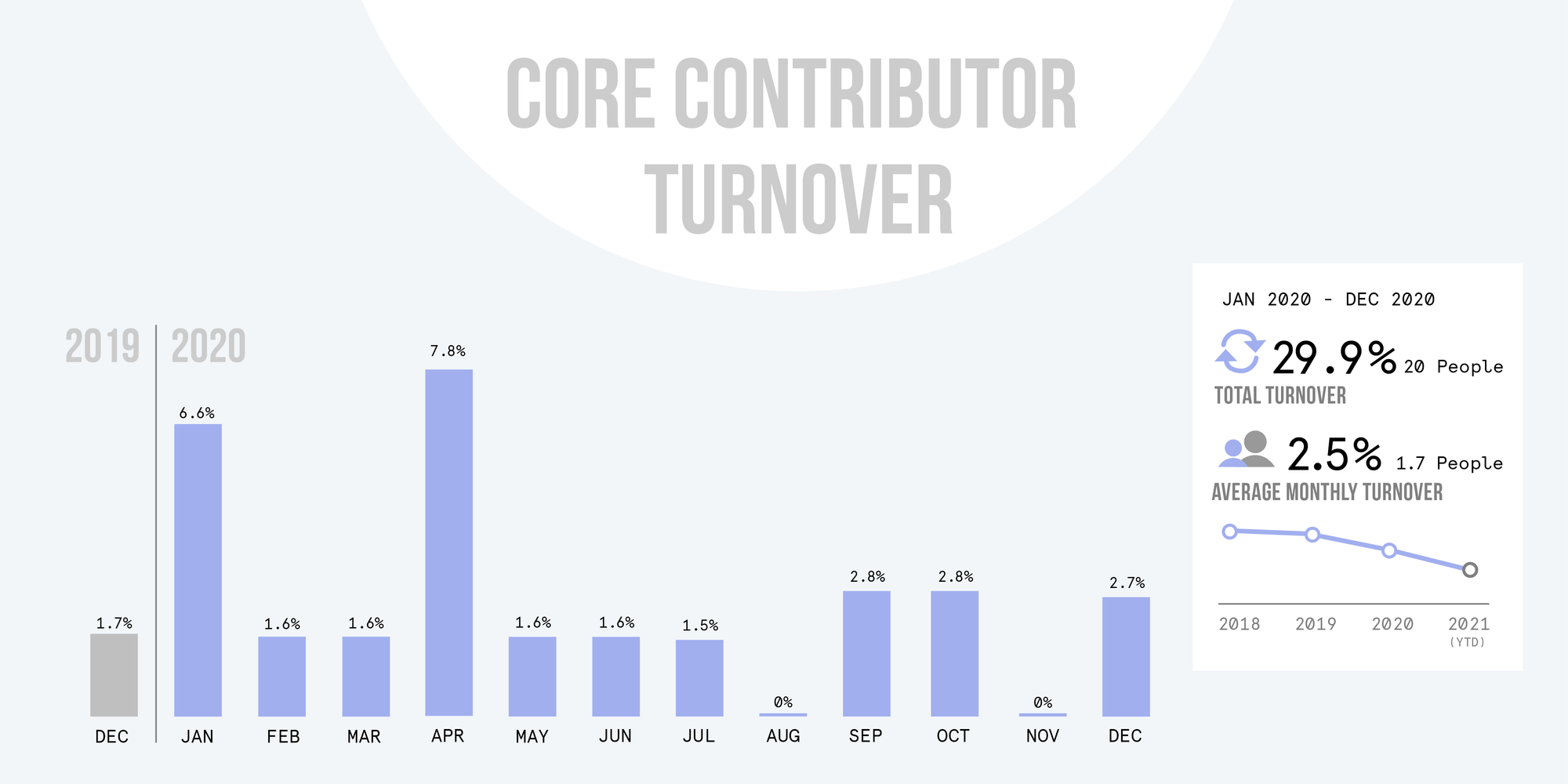
During Q4, we welcomed the following awesome core contributors to Status, adding new knowledge and super valuable skills to the project:
- @Shivek Khurana, Senior Developer in the Core Team
- @arijit_ad, Distributed Network Engineer with the Dagger Team
- @Hanno, Protocol Engineer
Ambassadors
In Q4 2020, we had 11 new ambassadors joining the Status Ambassador Program. The current number of Status ambassadors is now at 47, with representation across 28 countries.
Status ambassadors completed 109 tasks from October to December, broken down by category into: events (2), content (69), community building (3), and technical (35). There were more than twice as many technical contributions as the previous quarter and fewer events due to the global pandemic.
Some highlights from the program in Q4 2020:
- @Malik merged 15 pull requests and closed 2 issues for Status Desktop.
- @Jitendra organized a webinar introducing Status in Odia language.
- @Kuen made an explainer video and an infographic for Keycard.
- @Thiago translated our key blog posts and Status app copy into Brazilian Portuguese.
- @Vladimir, @HenryRoo, and @Yaroslav translated the Q3 quarterly report into Russian.
- @Laura translated 5 blog posts into Spanish.
- @Maxim published 3 videos explaining Status to the Russian community.
- 27 ambassadors participated in the referral program pilot and shared a lot of useful feedback with the team.
Translations
Our ambassadors and open source contributors helped spread the words of Status by translating Status into their languages. If you want to learn more about the translation campaign, visit translate.status.im.
Status translation
- Support 18 languages
- English, German, Spanish, French, Portuguese, Italian, Russian, Greek, Turkish, Indonesian, Arabic, Filipino, Korean, Japanese, Traditional Chinese, Simplified Chinese, Bengali and Vietnamese
- 27 contributors translated 46,429 words
Status.im website translation
- Support 16 languages
- English, Spanish, Portuguese, Simplified Chinese, Traditional Chinese, Korean, Japanese, Russian, German, French, Italian, Greek, Filipino, Malay, Indonesian, and Arabic
- 23 contributors translated 95,102 words
Many thanks to our translation heroes in Q4: HenryRoo, Mr. Twister, Sagor, Donald, Hisam, Marie, Erol, Kuanghen, Marco, Nasib, Max, Haruki, CryptoLove, Hamba, and Floyd.
8. A Look back at the year and ready for 2021
2020 was a wild year in many regards. There was a global pandemic. Ethereum boomed with lots of new projects, users, and the DeFi movement. Eth2 launched on mainnet. Markets fluctuated, and people flocked to private means of communication.
The Status Network is steadily making progress on all fronts including the mobile application, desktop client, Keycard, and underlying infrastructure in messaging and eth2. As Status matures as a product, network, and community, we continue to progress towards our goal of private, secure communication that upholds human rights. As we look to 2021, our strategy will center around:
- Focusing on user growth and retention by making an engaging, sticky, and compelling in-app experience in Status
- Putting in place foundational work on our next generation p2p infrastructure, allowing Status and many other projects in the ecosystem to scale robustly
- Supporting communities to grow and evolve inside of Status
- Laying the foundation for Status as a marketplace platform
Thank you for reading this report. We’re always excited to tell you about the work we do. Here’s hoping that wherever you might be, you’re safe and well. Take care!
- Your friends at Status
Appendix
Translations
A huge and heartfelt thank you to those who helped translate this report, we’re super grateful for your contribution:
- Spanish: José
- Portuguese: Thiago Lazzari
- Chinese: Steven | @steven20110906
- Korean: Jinho | @jinhojang6
- Japanese: Haruki | @Haruki
- Tagalog: Ken | @kenberey
- Russian: Yaroslav Kozhukhov | @mdckprd, Vladimir | @_madnessteat_, Henryroo | @sector_priz.
Disclaimer / fine print
This report was made for your entertainment, and we’d ask you not to rely on it for any other purposes, e.g. making investment decisions. Just to be super transparent, we want to highlight that:
- Token metrics information is an estimate supplied by a third party, given for illustrative purposes. We have not independently verified or fact checked this data.
- Financial information provided is based on available data as of the date of publication and may be subject to adjustment after release of this report. Numbers have been rounded for ease of presentation.
Thanks for your understanding!


